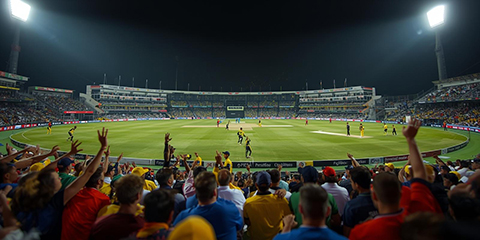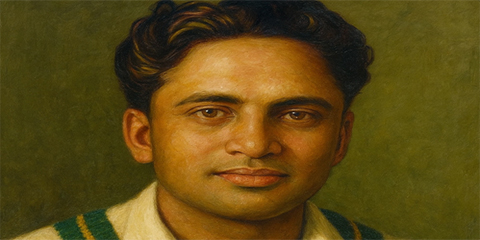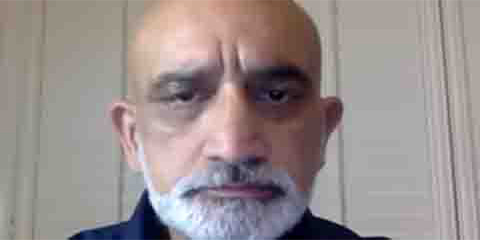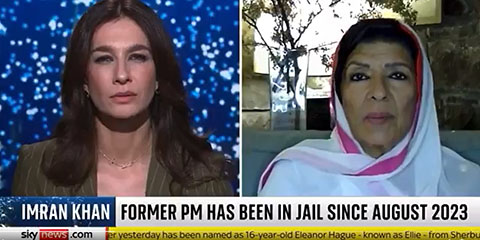How TV ratings rewrote Pakistan-India cricket rivalry
JournalismPakistan.com | Published 4 months ago | Dr. Nauman Niaz (TI)
Join our WhatsApp channel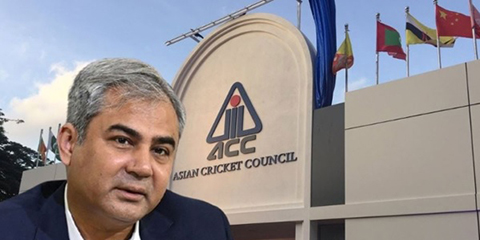
ISLAMABAD—There it was again, the primal wail from across the border. An uproar, frenzied and familiar. India’s media, gripped by its habitual hysteria, echoed a delusion that has outlived generations: that their country is the smartest, the cricketing Olympus, a superpower immune to defeat and allergic to concession. This wasn't analysis. It was performance art.
Patriotism, in its exaggerated Bollywooded avatar, morphed into paranoia. Pre-conflict, their chest beaters were already consumed by a peculiar, almost comic, optimism, painting Pakistan as a nation that would, as always, cower at the feet of a mightier neighbour. But once the surge of realpolitik turned, post-war sanity, if ever it existed never arrived. Their response? Obnoxiousness lacquered in nationalism, a script for the naive or those dutifully mouthing the state’s narrative. And, how the Indian media delivered.
It was as if they were trapped in a fever dream of Karan Johar melodrama, where Pakistan is forever villain, India forever invincible. Only this time, the real world, unlike cinema, didn’t yield to scripts. India was defeated, militarily embarrassed, diplomatically isolated. Yet, instead of humility, they flailed about, grabbing at straws like drowning men in designer suits. But the straw broke too.
When the BCCI, India’s boardroom giant, armed with the arrogance of billions, refused to send its team to Pakistan for the ICC Champions Trophy 2025, citing terrorism and vague security premonitions, it was déjà vu. A familiar playbook. Never mind that they had already signed, quite willingly, the ICC agreement to play in Pakistan. Never mind that the tournament, this time, wasn’t an invitation, it was an obligation.
Yet again, the BCCI tried the sleight-of-hand. But Syed Mohsin Naqvi, chairing the PCB, was not an easy mark. To his credit, Naqvi held firm. He didn’t beg. He didn’t bend. Instead, he stared the world’s richest cricket board in the eye and saw not a juggernaut, but a bluff. India, boasting skyscraping stadiums and a financial empire had no appetite for war on equal terms. And so, a compromise emerged. A hybrid model. Not born of diplomacy, but of pressure. Pressure not from cricketing idealism, but from television’s ravenous beast: the broadcasters.
Naqvi knew the game. If India wouldn’t set foot in Pakistan till 2027, then Pakistan would not play a single ball on Indian soil either. Call it parity. Call it poetic justice. But it played out exactly as he had scripted. And so, Pakistan will play its matches in the ICC Women’s World Cup 2025 and ICC T20 Men’s World Cup 2026 at neutral venues, refusing to adorn India’s vast amphitheatres with their presence. A triumph not in war rooms, but in meeting rooms. The subcontinent’s cricket had once been about artistry. Now it had been reduced to logistics. What fuelled this house of mirrors? Not honour. Not sovereignty. Not even ideology. Just pressure. From the broadcasters. The ones who truly rule cricket now. Nothing more. Nothing less.
In the muddied afterglow of conflict, when smoke still curled into the sky like the unspoken thoughts of wounded nations, cricket, always cricket remained the great theatre where politics pirouetted in whites or coloured clothing. And into this smouldering amphitheatre strolled Syed Mohsin Raza Naqvi. A man neither chiselled by cricket’s long summers nor its scorebooks, but one who had mastered power in the age of optics. By the calendar’s cold logic, his turn had arrived, rotation they called it, as if destiny were a bureaucrat and he took seat as President of the Asian Cricket Council.
The Timing was Breathless
The Asia Cup 2025, a tournament first to be hosted by India, now floated rudderless in a sea of geopolitical bile. New Delhi, still nursing the humiliation of Operation Sindoor decimated by Pakistan’s thunderous Bunyān un Marsoos was in no mood to pretend diplomacy. The wreckage was more than metallic: five Rafales fallen like vanity from the sky, six aircraft burnt into headlines, and with it, the illusion of invincibility. But pride, in India, had not perished. It had simply reinvented itself in denial.
Their media, carnival-esque and caffeinated, raged as if every studio had turned into a war room. Hashtags were drafted like battalions. And somewhere between anchors screaming and politicians posturing, the BCCI, that place of cricketing capitalism, had begun to contemplate boycotts.
They had already aligned Sri Lanka, Oman, and Afghanistan, a holy trinity of the manipulable to the idea that this Asia Cup could be scuttled, buried under the paperwork of postponement. Three defections, and the tournament would be delisted. The event, like all dreams born in South Asia, would be remembered not for what it achieved, but what it could’ve been. But Naqvi, unflinching, summoned the AGM to Dhaka, a city scarred by history but hosting another chapter now. When the BCCI refused to attend, many believed the curtain had dropped. That the farce had finally become tragedy.
Only, it didn’t. Naqvi played the long game, not with threats or speeches, but by simply not moving the meeting. Inaction, in the face of theatre, became action. And then, as if by divine absurdity, India blinked. Not only did they attend. They approved the itinerary. And like merchants bartering under the silk canopy of commerce, they added Oman and Hong Kong to the cast. not out of sporting virtue, but to expand the stage for the real protagonist: the broadcaster.
For in the end, it wasn’t patriotism that compelled compromise. It was airtime. More teams meant more matches. More matches meant more India-Pakistan. Group A now read like a broadcaster’s fever dream: India, Pakistan, Oman, UAE. Four teams, two real ones, and one inevitable outcome: at least two India-Pakistan matches. Perhaps even a final, to make it three. A trilogy. A saga. A bankable myth.
That Pakistan, on paper, is weaker than India is not a detail, it is the very premise of the drama. Weakness sustains the myth of redemption. And broadcasters understand that myths sell far better than matches. For in Pakistan, there is memory. Of Sharjah. Of Karachi. Of Javed Miandad’s last ball six, Aaqib Javed’s seven wickets in the ODI including a hat-trick, Misbah Ul Haq’s scoop and Shahid Afridi’s sixes. Of Wahab Riaz’s tears and Babar Azam’s elegance. Pakistan may lose, but it loses in poetry. And poetry, in a world of algorithms, remains undefeated.
So ask not why Pakistan is a broadcaster’s lifeline. Ask why, in a world where everything has become content, only Pakistan still offers a story. A story that begins in Dhaka, with a meeting, and ends, perhaps with a final no one will ever forget. And somewhere, Mohsin Naqvi watched quietly, not as a cricket man, but as a man who knew cricket was no longer a sport. It was a spectacle spun with wires, entwined through satellites, and stitched forever into the politics of this broken subcontinent.
People didn’t realise the stakes soar and taking radical decisions of getting the tournaments suspended is beyond the boards even the governments. ICC tournaments or even the Asia Cups involves huge money. Two, the investments by the broadcasters need to have returns. Production costs are extremely high so are the value of the rights. Also, there are three types of cricket economies, white, grey, and black. Powerful people, with influence run these. Private leagues are franchise based, and the majority of the franchise owners are those who have had it have stakes. Franchise cricket is overriding even international cricket.
Cricket between India and Pakistan has always been more than sport, it is a ceremony of nerves, a role playing of memory, and a proxy for everything the subcontinent left unresolved in 1947. But in the ashes of the recent 2025 skirmishes, more border tensions than full-scale war, but magnified by the lens of nationalism and 24-hour newsrooms, the already fragile corridor between bat and ball has fractured further. What remains today is a relationship defined not by rivalries on the field, but by vendettas off it.
It wasn't long ago that the cricketing nations of South Asia flirted with hope. The 2023 ODI World Cup had its diplomatic moments. The hybrid model for the 2023 Asia Cup was begrudgingly accepted. Players smiled, shook hands, and gave soundbites of peace. But that was before the spring of 2025, before rhetoric became doctrine, and doctrine became fire.
Since then, India’s cricketing apparatus, once veiled in administrative diplomacy, has pulled on the robes of performative patriotism. The BCCI, once a board of balance, has aligned itself openly with the nation’s muscular foreign policy, orchestrated by a BJP government that sees cricket as both weapon and thespianism. And nowhere is this more apparent than in its dealings with Pakistan. The Champions Trophy Conundrum.
Pakistan, after years of exile and undercurrents, was awarded the hosting rights for the 2025 ICC Champions Trophy, a affirmation from the ICC, perhaps, to its improved security infrastructure and successful hosting of Pakistan Super League matches. But India’s reaction was swift, rehearsed, and rooted in policy masquerading as morality: we will not play in Pakistan.
The BCCI’s stance, heavily choreographed with the Ministry of External Affairs, was not just a refusal, it was a narrative. One where Pakistan is painted as rogue, unsafe, unworthy. And the chorus behind that narrative is not sung by players, but by India’s mainstream media, now more megaphone than mirror. Studios became war rooms. Anchors pounded desks. ‘How can we play in Pakistan?’ they asked, not as a question, but as a condemnation. Gone were the nuances of diplomacy. Gone were the reminders that India had sent its players to Sri Lanka, Dubai and England to face Pakistan even during deeper geopolitical crises. Instead, the message was singular: Playing Pakistan is betrayal. Talking peace is sedition. Asia Cup 2026 and the Ghosts of 2023.
The Asia Cup 2026 now looms, drenched in the same uncertainty. The 2023 edition, held via a hybrid model, was a reluctant compromise: Pakistan hosted a few matches in Lahore, but India never crossed the border. The arrangement, while functional, was nothing more than a diplomatic placebo. Now, with the BJP government seeking a third term and riding a wave of hyper-nationalism, cricketing diplomacy is off the table. Elections are televised theatre, and Pakistan is the perfect antagonist. In this script, the BCCI is no longer just a cricket board, it is a nationalistic instrument, its scheduling aligned with poll dates, its silence louder than its statements.
Asia Cup 2026, therefore, may not happen at all. Not with Pakistan as a stakeholder. Not with India unwilling to travel. The ACC, caught between posturing and policy, offers no resistance. The ICC remains a bystander. And broadcasters, ever-hungry for India-Pakistan eyeballs wait in vain.
The Exaggerated Patriotism of Indian Media
What was once passionate is now parody. Newsrooms in India, especially the primetime gladiators, have turned cricket into a test of nationalism. Players are no longer athletes, they are soldiers in jerseys. A dropped catch is ‘letting the nation down.’ A handshake with Babar Azam becomes betrayal. Analysts, once tasked with dissecting technique, now debate geopolitics in pixelated fury.
Gone are the days of Sunil Gavaskar’s restraint, Harsha Bhogle’s diplomacy. Now it’s all about ratings. About hashtags. About screaming louder than the ball travels. The villain is not just Pakistan, it is anyone who dares to suggest cricket should be kept separate from conflict. And The Players? Silenced. Coached. Coerced.
Few dare speak honestly. Players, especially in India, have become diplomats in whites and coloured flannels, fearful of tripping the wrong narrative. Virat Kohli once walked over to Babar Azam after a T20 World Cup match to share a quiet moment. Today, such gestures are cropped, criticised, dissected for signs of ideological weakness. In Pakistan, the response is quieter but no less bitter. They see a game denied, a generation robbed. They remember 2004 and 2005, the Lahore crowds clapping for Virender Sehwag, the Indian flag flying next to Pakistan’s in Rawalpindi. Now, they see closed doors, empty stadiums, and a neighbour too proud to play, yet too powerful to ignore.
The Road Ahead
Isolation or Introspection? Cricket once survived wars. It healed wounds when politics failed. But now, it has become the casualty, a game played not on the field, but in studios, manifestos, and nationalistic algorithms. India versus Pakistan is no longer a match. It is a metaphor. For what we've lost. For what we refuse to rebuild.
And as the world watches, hungry for that magical tension only Indo-Pak contests bring, the game itself fades, not in defeat, but in deliberate abandonment. Because when cricket becomes propaganda, when broadcasters choose borders over boundaries, and when administrators take orders instead of decisions, the scoreboard no longer matters.
Only the silence between two anthems does. In the beginning, the game belonged to its players. The bat carved its narrative, the ball dictated fate. Administrators, for all their pomp and paperwork, were only the stagehands, shuffling behind the curtains while the sun slanted across the pitch. The crowd came, stood on mounds or perched on wooden benches, and watched. No angles. No replays. No graphics. Just the drama of bat versus ball, unedited and unsold. Then came the lens. And everything changed.
If cricket once answered to the rhythms of play, it now genuflects to the red light of the camera. The umpire’s finger waits until the producer cuts to a wide shot. The drinks break arrives not when players are parched, but when advertisers are restless. What was once a sport of rituals and randomness has become a scripted ballet of sponsors, segments, and screen time. The shift was slow, almost invisible at first. Kerry Packer lit the fuse in the late 1970s, his World Series Cricket offering coloured kits, floodlights, and players paid not by their boards, but by the broadcaster. He was exiled, of course, dismissed as a rebel. But as history would show, he wasn’t an outcast. He was a prophet.
In the decades since, the camera has morphed from observer to overlord. And now, in 2025, cricket’s soul isn’t in the dressing room, the boardroom, or even in the bleachers—it is in the control room, nestled beside the director, the commercial producer, and the live feed supervisor. International cricket, once the pinnacle, now bends to broadcaster preferences like a cricketer to spin on a turning fifth-day track. No series is truly bilateral anymore. Each is triangulated by ‘ratings potential’, with broadcasters pulling the strings. India won’t tour without a prime-time guarantee. Ashes dates are carved to slot seamlessly into TV networks’ winter content calendars. And South Africa? They’ll shuffle their domestic schedule if it means a broadcast boost from a visiting Indian team.
But it is in franchise cricket that the broadcasters’ grip tightens into something more anatomical. Leagues exist not to grow the game, but to harvest eyeballs. They are television formats first, cricket second. Teams are brands. Commentary is performance. Every ball is a content moment, clipped and tweeted before the next one is bowled. The IPL, of course, is the god-tier template. The ‘strategic timeout’ isn’t a cricketing pause, it’s an ad inventory. The auctions are no longer talent scouting exercises, they are televised drama, with players as commodities and owners as dramatic protagonists. And the broadcasters? They’re not covering the game, they’re curating it.
The power has shifted. From selectors to sponsors. From captains to content creators. From boards to broadcast czars. Administrators, once bloated with self-importance, are now just intermediaries. Players, despite their fan followings and fortunes, are pawns moved by multi-camera coverage and replay packages. Even the ICC, that supposed global overseer, has become a facilitator of rights deals, a licensing body for cricket’s next Netflix moment. This is a world where players are told what to wear, how to celebrate, when to speak, and to which camera they must look. Their private moments, tears, curses, confessions are harvested for content. Dissent is not punished by fines alone, but by a silent sidelining from the broadcaster’s narrative. You don’t just fall out of form anymore, you fall out of frame.
Even national boards, traditionally the hoarders of power, have had to strike partnerships, Star here, Sky there, Jio in the wings, trading sovereignty for solvency. No longer can a cricket board determine its own calendar without first securing a ‘broadcast window.’ And the fans? They’re now consumers with data points. Their cheers measured in decibels, their attention bought and sold, sliced into demographics, regional preferences, and ad impressions. The crowd is no longer a witness, it is a monetisable asset.
Yes, the broadcasters brought clarity, replays, storytelling, money. They gave voice to cricket’s beauty and visibility to its nuance. But they also shackled it. What was once a game played in the sunlight of spontaneity now exists under floodlights of control. The players may still wear the jerseys. The captains may still toss the coin. The administrators may still call the pressers. But make no mistake—it is the broadcaster who decides when the match starts, where it ends, and what story is told in between.
The cricket you love is no longer just sport. It is programming. In the landscape of India’s restless, ever-shifting media empire, a new giant was born, not in silence, but in the noise of contracts signed in boardrooms glazed with ambition. The child of three titans, JioStar India Private Limited emerged not only as a joint venture, but as a statement, an echo of power, a contemplation of the future. Once known to the world as Disney Star, the entity has been re-christened and repurposed under the commanding gaze of Reliance Industries Ltd (RIL), who now shepherd the empire’s new direction with calculated poise.
The shareholding map is a modern cartographer’s dream: Reliance headed by Mukesh Ambani, the richest man and influencer in India and one of the richest in the world with his assets worth USD 115.3 billion, the industrial colossus, holds 16.34%, a stake measured not in volume but in vision; Viacom18, with its muscular entertainment sinews, grips 46.82%; and Disney India, the master storyteller from the West, retains 36.84%, anchoring itself in the mythos it helped create. In this triangulation of influence, JioStar doesn’t just operate, it orchestrates. And jointly they hold 40% of the total outlay of India’s deep market.
The union didn’t come cheap. Valued at a staggering, a cool US $8.5 billion. And yet, Reliance dug deeper, injecting a further US $1.4 billion as if to remind the world that cash was never the question, only scale and supremacy. Star India was once pegged at ₹26,000 crore, Viacom18 at ₹33,000 crore, but together, tethered to digital ambitions and linear legacy, the new monolith soared into valuation altitudes only few dared dream of.
But the true muscle of JioStar lies not in balance sheets, it lies in broadcast. With a network of over 120 television channels, the entity stands like a colossus astride Indian screens. Disney Star’s arsenal, nearly 70 channels spans from StarPlus and Star Gold to Star Sports 1, 2, 3, to the digital-injected Star 4K. It’s a stable that runs from the drama-soaked alleys of Star Jalsha to the vast football fields where Star Sports Select hums with multilingual fervour.
Viacom18, meanwhile, brings its own arsenal to this marriage of might. From Colors TV and its shimmering sub-brands (Rishtey, Cineplex, Infinity) to its youth-and-pulse-driven offerings, MTV, Nickelodeon, Sonic, Nick Jr., this is a library that speaks to both nostalgia and novelty. Former titans like VH1 and Comedy Central, now rebranded or vanished, live on in legacy.
Yet the future lies not in channels alone, it lies in the stream. In February 2025, two mighty rivers met: Disney+ Hotstar and JioCinema merged into JioHotstar, the streaming heart of the JioStar revolution. With over 300,000 hours of content, it offers everything from IPL screams to Marvel dreams. It is regional, it is global, it is India’s screen made infinite. Behind the scenes, the regulatory machinery churned and approved. The Competition Commission of India (CCI) and the National Company Law Tribunal (NCLT) granted their blessings on the condition that some regional excesses be pruned, some advertising bundling be restrained. It was governance with a scalpel, not a sledgehammer.
And so, by November 2024, the metamorphosis was complete. JioStar stood crowned as India’s largest media and entertainment company, divided into three CEO-led divisions: entertainment, digital, and sport. It is no longer just a company—it is a constellation of content, a galaxy of influence, a new mythology being written in pixels and ratings. It is the redrawing of India’s broadcast map, an act of empire in an age of algorithm. Some matches are played on green fields. Others are played on screens. And then, there are matches that are played everywhere—on pitches and pavements, in lungs and larynxes, in living rooms and loading bars, in remote villages with cracked satellite dishes and in chrome-plated iPhones in Dubai’s high-rises. These are India–Pakistan matches. Not games. Not contests. But full-blown cultural supernovae played as much in the pixels as in the pauses between them. Every time these two sides meet, somewhere a satellite groans. Servers sweat. Ratings rise like a tide that knows no moon.
The World of Broadcast
In the world of broadcast, there is cricket. And then, there is India vs Pakistan. The last time they met in the Asia Cup, in 2023, the number wasn’t just a rating, it was scripture: 2.8 billion minutes consumed. A number so big that it became meaningless and sacred in the same breath. Linear TV alone, in India, touched over 220 million viewers—more than the population of Brazil. And on digital? The beast was hungrier. Hotstar, JioCinema, YouTube mirrors in strange corners of the internet, each bearing witness to a clash not between two teams but two histories, two wounded dreams, two nations who speak the same language but scream it differently. In 2022, during the T20 World Cup clash at the MCG, a match that moved like music, that rose like a prayer and ended in a Virat Kohli crescendo—Disney+
Hotstar hit record-breaking concurrent viewership. 18.6 million streams. At once. Together. Breathing as one. Each subsequent tournament only fanned the fire. In 2024, again in the Asia Cup, the group stage match was watched by over 240 million people across platforms. The rain intervened, as if the gods themselves were desperate to prolong it. The replay match, rescheduled, reshaped was devoured again. Advertisers didn’t sponsor the match. They mortgaged their futures for seconds of screen time. There are elections in India that don’t get this kind of attention.
In Pakistan, the story is humbler, but no less poetic. PTV and Ten Sports broadcast the same frames. But they do so with the tremble of hope, not the roar of entitlement. Every ball off Shaheen Shah Afridi’s hand. Every Babar Azam glance. Every Mohammad Rizwan struggle.These are not moments, they are memories in motion. The viewership hits in Pakistan cross 80 million when India is on the other side. On Tamasha, ARY ZAP, and A Sports' YouTube streams, concurrent views spike like heart rates in the 19th over. But it is not about the number. It is about the national exhale.
India v Pakistan is not an appointment to view. It is an obligation. It is the only time the markets pause, the streets still, and weddings halt the baraat. It is both countries looking at the same thing at the same time, with different hearts. One hopeful. One anxious. And then they switch. It doesn’t matter whether it is the Asia Cup, the World Cup, the Champions Trophy, or a fantasy future tri-series that may never exist—this fixture sells itself. Broadcasters know this. So do advertisers. So does the ICC. It is why every tournament now feels reverse-engineered just to have that one match. Even if it rains. Even if it ends in a no-result. Even if it ends before it begins. Because the rating is the result. The TRP is the trophy. And every India-Pakistan game is a World Cup final masquerading as a group stage encounter.
When Virat Kohli pulled. When Babar Azam leaned. When Shadab Kha did his little jig after a wicket. When Hardik Pandya screamed into the void. The world watched. Not listened. Watched. Because this is not cricket. This is the broadcast of a century-long story, told in overs and interruptions, in sixes and slow-mos, in drama and dread and dopamine. India vs Pakistan is not a game. It is a global heartbeat. And ratings are its echo. The marquee India–Pakistan match during the ICC Men’s Champions Trophy 2025 drew a staggering 206 million TV viewers in India alone. It generated 26.5 billion minutes of linear TV watch time, about 10.8% higher than the India–Pakistan fixture in the 2023 World Cup On JioHotstar (OTT), the match saw 61.1 crore (611 million) digital views, dwarfing prior benchmarks (e.g., 22.5 crore views in 2023). Pre , mid , and post match shows like ‘Dil Se India’ and ‘Oaksmith Cricket’ Live added ~2.2 crore additional viewers
Overall tournament viewership: ~250 billion minutes watched across platforms in India, 137 billion on TV (Star Sports), 110 billion on digital (JioHotstar) The final (India vs New Zealand) achieved 230 million TV viewers and peak concurrency of 122 million, with 61 million simultaneous digital viewers during the climax . This makes Champions Trophy 2025 the highest-rated ICC multi-nation tournament ever in India, surpassing the 2023 World Cup by roughly 23%.
In the beginning, there was radio. And then there was light. And then there is Jio. The numbers? US$3.1 billion for the ICC global rights from 2023 to 2031, a number so large that it stopped being a figure and became a philosophy. And the IPL? The golden goose that never stops laying eggs but somehow also multiplies every time it's cooked. US$6.2 billion over four years. Not broadcasting. Not streaming. But both. Digital and linear, cut down the middle like a Rohit Sharma cover drive—precise, brutal, inevitable. So what does all this money buy? Influence. A seat not just at the table but the head of it. A voice that doesn't shout but whispers into the ears of boards, governments, and even the gods of scheduling. When broadcasters sign cheques the size of small national budgets, tournaments are not hosted—they are choreographed. Like weddings. Like wars.
And so, in July 2024, the BCCI—normally rigid with the righteousness of geopolitics—walked into the ACC AGM hosted by Pakistan, albeit on neutral ground. It was an act not of diplomacy but of necessity. The camera sees all, and the camera is paid for by Jio Star. The coffers needed filling, the IPL calendar needed protecting, the Asia Cup schedule needed sealing. And so pride was folded like a linen napkin and placed beside the protocol. The ACC meeting wasn’t about neighbours or narratives. It was about pixels, production trucks, and primetime.
In this new cricketing cosmology, India doesn’t just field players. It fields fibre-optic cables, satellites, and user interface design. The bowlers bowl, the batters bat—but the real magic is in the switch room, where content flows like blood through the veins of subcontinental fandom. And Jio Star? It doesn’t just broadcast matches. It broadcasts meanings. It decides who matters. It rewrites what tradition looks like in 4K. This is the world now. The toss happens in Colombo.
But the decision? That’s made in Lower Parel. Cricket, once a colonial inheritance, then a nationalist symbol, now floats in the ether of digital capital. And somewhere, under the flicker of ten million smartphone screens, a six is struck, a match is won, and a continent silently affirms—not to the team that triumphed, but to the broadcast that made it possible. So, it wasn’t diplomacy or skill of Mohsin Naqvi or the agenda of BCCI but broadcasting stakes and backdoor impact of those who run not only cricket white but grey and black economy.
Dr. Nauman Niaz is a civil award winner (Tamagha-i-Imtiaz) in Sports Broadcasting & Journalism, a regular cricket correspondent having covered 54 tours and three ICC World Cups, having written over 3500 articles. He has authored 15 books and is the official historian of Pakistan Cricket (Fluctuating Fortunes IV Volumes - 2005). His signature show: Game On Hai has been the highest on ratings and acclaim.








